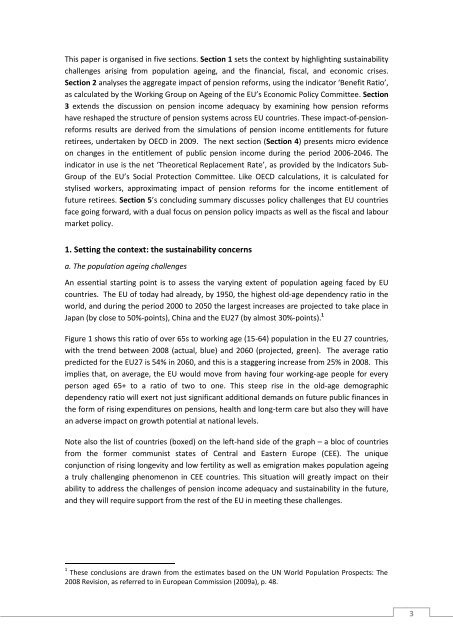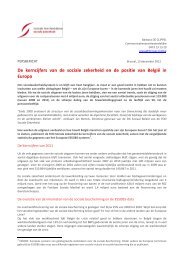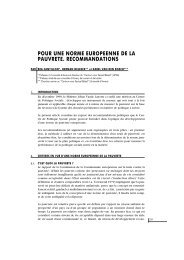Sustainability and adequacy of pensions in EU countries. A cross ...
Sustainability and adequacy of pensions in EU countries. A cross ...
Sustainability and adequacy of pensions in EU countries. A cross ...
Create successful ePaper yourself
Turn your PDF publications into a flip-book with our unique Google optimized e-Paper software.
This paper is organised <strong>in</strong> five sections. Section 1 sets the context by highlight<strong>in</strong>g susta<strong>in</strong>ability<br />
challenges aris<strong>in</strong>g from population age<strong>in</strong>g, <strong>and</strong> the f<strong>in</strong>ancial, fiscal, <strong>and</strong> economic crises.<br />
Section 2 analyses the aggregate impact <strong>of</strong> pension reforms, us<strong>in</strong>g the <strong>in</strong>dicator ‘Benefit Ratio’,<br />
as calculated by the Work<strong>in</strong>g Group on Age<strong>in</strong>g <strong>of</strong> the <strong>EU</strong>’s Economic Policy Committee. Section<br />
3 extends the discussion on pension <strong>in</strong>come <strong>adequacy</strong> by exam<strong>in</strong><strong>in</strong>g how pension reforms<br />
have reshaped the structure <strong>of</strong> pension systems a<strong>cross</strong> <strong>EU</strong> <strong>countries</strong>. These impact-<strong>of</strong>-pensionreforms<br />
results are derived from the simulations <strong>of</strong> pension <strong>in</strong>come entitlements for future<br />
retirees, undertaken by OECD <strong>in</strong> 2009. The next section (Section 4) presents micro evidence<br />
on changes <strong>in</strong> the entitlement <strong>of</strong> public pension <strong>in</strong>come dur<strong>in</strong>g the period 2006-2046. The<br />
<strong>in</strong>dicator <strong>in</strong> use is the net ‘Theoretical Replacement Rate’, as provided by the Indicators Sub-<br />
Group <strong>of</strong> the <strong>EU</strong>’s Social Protection Committee. Like OECD calculations, it is calculated for<br />
stylised workers, approximat<strong>in</strong>g impact <strong>of</strong> pension reforms for the <strong>in</strong>come entitlement <strong>of</strong><br />
future retirees. Section 5’s conclud<strong>in</strong>g summary discusses policy challenges that <strong>EU</strong> <strong>countries</strong><br />
face go<strong>in</strong>g forward, with a dual focus on pension policy impacts as well as the fiscal <strong>and</strong> labour<br />
market policy.<br />
1. Sett<strong>in</strong>g the context: the susta<strong>in</strong>ability concerns<br />
a. The population age<strong>in</strong>g challenges<br />
An essential start<strong>in</strong>g po<strong>in</strong>t is to assess the vary<strong>in</strong>g extent <strong>of</strong> population age<strong>in</strong>g faced by <strong>EU</strong><br />
<strong>countries</strong>. The <strong>EU</strong> <strong>of</strong> today had already, by 1950, the highest old-age dependency ratio <strong>in</strong> the<br />
world, <strong>and</strong> dur<strong>in</strong>g the period 2000 to 2050 the largest <strong>in</strong>creases are projected to take place <strong>in</strong><br />
Japan (by close to 50%-po<strong>in</strong>ts), Ch<strong>in</strong>a <strong>and</strong> the <strong>EU</strong>27 (by almost 30%-po<strong>in</strong>ts). 1<br />
Figure 1 shows this ratio <strong>of</strong> over 65s to work<strong>in</strong>g age (15-64) population <strong>in</strong> the <strong>EU</strong> 27 <strong>countries</strong>,<br />
with the trend between 2008 (actual, blue) <strong>and</strong> 2060 (projected, green). The average ratio<br />
predicted for the <strong>EU</strong>27 is 54% <strong>in</strong> 2060, <strong>and</strong> this is a stagger<strong>in</strong>g <strong>in</strong>crease from 25% <strong>in</strong> 2008. This<br />
implies that, on average, the <strong>EU</strong> would move from hav<strong>in</strong>g four work<strong>in</strong>g-age people for every<br />
person aged 65+ to a ratio <strong>of</strong> two to one. This steep rise <strong>in</strong> the old-age demographic<br />
dependency ratio will exert not just significant additional dem<strong>and</strong>s on future public f<strong>in</strong>ances <strong>in</strong><br />
the form <strong>of</strong> ris<strong>in</strong>g expenditures on <strong>pensions</strong>, health <strong>and</strong> long-term care but also they will have<br />
an adverse impact on growth potential at national levels.<br />
Note also the list <strong>of</strong> <strong>countries</strong> (boxed) on the left-h<strong>and</strong> side <strong>of</strong> the graph – a bloc <strong>of</strong> <strong>countries</strong><br />
from the former communist states <strong>of</strong> Central <strong>and</strong> Eastern Europe (CEE). The unique<br />
conjunction <strong>of</strong> ris<strong>in</strong>g longevity <strong>and</strong> low fertility as well as emigration makes population age<strong>in</strong>g<br />
a truly challeng<strong>in</strong>g phenomenon <strong>in</strong> CEE <strong>countries</strong>. This situation will greatly impact on their<br />
ability to address the challenges <strong>of</strong> pension <strong>in</strong>come <strong>adequacy</strong> <strong>and</strong> susta<strong>in</strong>ability <strong>in</strong> the future,<br />
<strong>and</strong> they will require support from the rest <strong>of</strong> the <strong>EU</strong> <strong>in</strong> meet<strong>in</strong>g these challenges.<br />
1 These conclusions are drawn from the estimates based on the UN World Population Prospects: The<br />
2008 Revision, as referred to <strong>in</strong> European Commission (2009a), p. 48.<br />
3

















